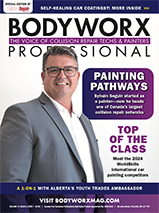HOW-TO, ON GLUE
USING GLUE PULL REPAIR TO GET THE DENTS OUT
By Sarah Perkins
With the ever-increasing advancement of technological change within the automotive industry, and the growing advancement of parts and features within vehicles, sometimes, it’s just better to get back to basics. At least, this is what the growing trend of glue pull repair suggests.
While not a brand new technique—having been initially developed in the United States in 1999 and commercialized in the early 2000s— increased awareness of the possibilities for dent repair that does not compromise advanced vehicle panel systems has brought glue pull repair into the spotlight.
Glue pull repair is not paintless dent repair, however, it does offer many similar applications. According to Yves Robichaud, the Regional Director for Quebec at CARSTAR Canada, “dent removal using glue saves time by reducing the surface preparation stage.”
Fix Network’s Regional Vice President for Quebec, Yves Roy further reflects these sentiments stating that glue pull repair is “a very interesting approach because it preserves the integrity of the parts and allows for faster execution.”
The process itself involves a series of simple steps. A panel needing repair is first cleaned with a 95 percent alcohol solution before activating the glue gun to the correct temperature needed for the specific repair. Next, a flashlight blast is used to remove dust and moisture before applying the glue. Here, reusable blocks are positioned where the dent is located (and this is much like using welded wrenches without having to remove the part or bare the surface). When the glue has dried, the process becomes a simple matter of pulling with the same type of bar used with welded keys. Once the dent is released, the glue can then be dissolved with the same alcohol solution used for the initial cleaning.
Referred to by supporters of the process as the “least invasive collision repair technique,” glue pull repair offers many potential advantages over traditional systems.
Since a vehicle’s original siding is left untouched throughout the entire process, the use of glue pull repair can make it easier for auto body technicians overall to detect and correct other dents in panels and siding.
Similarly, because the paint and finish are preserved, and since the paint is only slightly heated during cleaning, glue pull repair can help to protect a vehicle’s anti-rust coating and e-coating applied by the vehicle’s manufacturer. While studs and wires are traditionally welded on to correct dents and often pull or rip holes into aluminum leaving additional work for auto body technicians, using glue pull repair on steel and aluminum can allow for no extra metal work areas or holes.
This change is in comparison to the early development of the process in which the adhesives and tabs used were often too weak and broke during repairs.
Another potential advantage of glue pull repair is the reduced use of body fillers and paint since the process can be done without creating additional fixes.
With the increasing technification of vehicles as the automotive industry races to reach electrification, glue pull repair also offers potential EV benefits and room for future growth. Vehicle panels now contain more wiring, electronics and insulation on the back, and sensors and e-coatings on the front than ever before. Through the use of glue pull repair, the delicate electronic systems found in electric vehicles can be preserved and technicians could be saved from having to open up parts of the vehicle that could otherwise interfere with computer or high-voltage systems.
While there is still a ways to go in terms of testing and technique, for supporters, the current most obvious opportunity for glue pull repair is small, shallow dents on forgiving panel materials. This includes potential work on roof panels, doors, interior dashboards, hoods, deck lid flanges, among other applications.
As with anything, it will take time, practice and patience before the full potential of glue pull repair is seen. However, with the use of adhesives expanding overall in the automotive industry as vehicle weights decrease and electric vehicles demand more diversified parts, the use of glue pull repair seems to be one that’s going to stick around, at least for the near future.






















